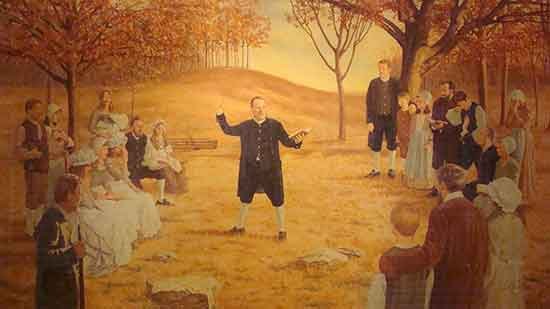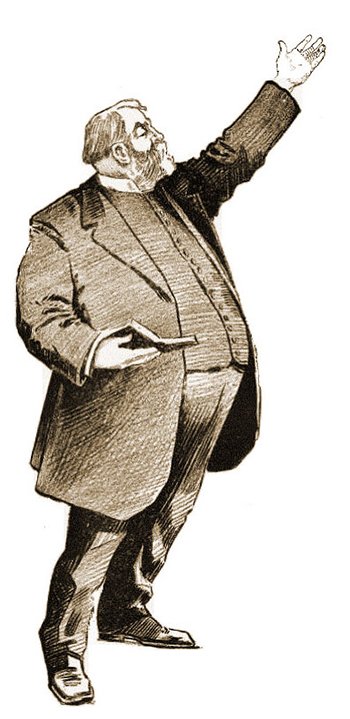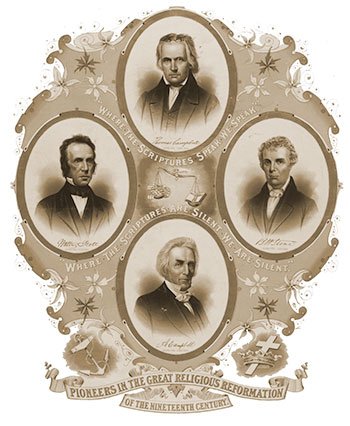1755 Sandy Creek Revival

Shubal Stearns Preaching
Antecedents of the Revival
The Sandy Creek Revival emerged within the larger context of the Great Awakening, a transatlantic religious movement that swept through the American colonies in the 18th century. This period witnessed a surge in evangelical fervor, emphasizing personal conversion experiences and emotional expressions of faith1. The Great Awakening challenged traditional religious establishments and fostered the growth of new denominations, including Baptists2.
Prior to the arrival of Shubal Stearns, the Separate Baptist movement had already begun to take root in New England3. This movement arose from divisions within Congregational churches, with some members seeking a more experiential and emotional form of worship3. These “New Lights,” as they were called, embraced the tenets of the Great Awakening and emphasized the importance of personal conversion and a “new birth” experience3.
They differed from regular Baptists in their rejection of strict Calvinism and predestination, calling instead for a “radical reorientation of life” that resonated with the common man4.
The Great Awakening in Virginia
The Great Awakening’s impact was not limited to New England. In Virginia, the movement gained momentum in the 1740s, fuelled by the preaching of itinerant evangelists like George Whitefield1. One notable figure in the Virginia Awakening was Samuel Davies, a Presbyterian minister who arrived in Hanover County in 17471. Davies’s passionate preaching and his efforts to reach enslaved people with the Christian gospel contributed significantly to the growth of evangelicalism in the colony1.
The rise of evangelicalism in Virginia also witnessed the emergence of Methodists, who, like the Baptists, emphasized personal experience and emotional expression in their worship1. The Great Awakening in Virginia laid the groundwork for the religious fervor that would soon erupt at Sandy Creek1.
The Spark that Ignited the Revival
Shubal Stearns, a charismatic preacher originally from Boston, played a pivotal role in initiating the Sandy Creek Revival5. Stearns had been converted under the preaching of George Whitefield, a prominent figure in the Great Awakening, and subsequently embraced Baptist beliefs6. In 1755, Stearns, along with a small group of followers, established the Sandy Creek Baptist Church in the Piedmont region of North Carolina5.
Stearns left his pastorate in Virginia and moved to Sandy Creek because he felt a spiritual burden for the unchurched farmers in the North Carolina backcountry4. He recognized the religious enthusiasm of these settlers and sought to bring them the message of the Separate Baptists4. Stearns’s preaching, characterized by a distinctive “holy whine” and an intense, mesmerizing stare, captivated audiences and sparked a wave of religious fervor7.
His emphasis on personal conversion, emotional expression, and the importance of the “new birth” resonated deeply with the people of the backcountry7.
The church at Sandy Creek practiced nine rituals that distinguished them from other denominations: baptism by full immersion, feet washing, the Lord’s Supper, laying on hands, anointing the sick, love feasts (communal meals), the “right hand of fellowship,” the “kiss of charity,” and devotion to children4. These practices, combined with Stearns’s passionate preaching, contributed to the rapid growth of the church and the spread of the revival4.
Stearns was also influenced by Separate Baptist pastor Waitstill Palmer, who had also been inspired by Whitefield’s preaching7. Palmer’s emphasis on believer’s baptism and experiential faith further shaped Stearns’s theology and ministry7.
Key Leaders of the Revival
While Shubal Stearns is recognized as the primary leader of the Sandy Creek Revival, other figures also contributed to its growth and impact. Daniel Marshall, Stearns’s brother-in-law, played a significant role in establishing the church and spreading the revival’s message4. Marshall, along with other ministers like Joseph Breed, accompanied Stearns on preaching tours throughout the region, establishing new churches and baptizing converts7.
The Sandy Creek Association, formed in 1758, served as a central hub for the Separate Baptist movement4. This association, led by Stearns, promoted evangelism, church planting, and the spread of Baptist beliefs throughout the South8.
Impact and Lasting Legacy
The Sandy Creek Revival had a profound impact on religion and society in the American South. Within a few years, the church at Sandy Creek grew from a small gathering of sixteen members to over six hundred4. The revival’s influence extended far beyond North Carolina, with Baptist churches springing up throughout the South6.
The revival also contributed to the growth of religious freedom in the colonies1. The Separate Baptists challenged the established Anglican Church and advocated for the separation of church and state9. Their emphasis on individual liberty and the priesthood of all believers resonated with the growing democratic ideals of the time1.
The Sandy Creek Revival left a lasting legacy on the Baptist denomination in the South4. It fostered a distinct form of Baptist faith characterized by emotional expression, evangelistic zeal, and a commitment to church planting9. The revival’s emphasis on personal experience and the “new birth” continues to shape Baptist beliefs and practices today9. The revival also contributed to the development of evangelicalism in the South, with its focus on personal conversion, emotional expression, and the authority of Scripture9.
The Sandy Creek Revival’s impact extended beyond the realm of religion. The Separate Baptists’ beliefs and practices influenced social and political attitudes in the South4. Their emphasis on individual liberty and their opposition to established authority contributed to the growing spirit of independence that would eventually lead to the American Revolution4.
Opposition and Controversy
Despite its widespread impact, the Sandy Creek Revival also faced opposition and controversy. Some religious leaders, particularly those from the established Anglican Church, viewed the Separate Baptists’ emotionalism and their challenge to traditional authority with suspicion8. One Episcopalian minister even attempted to rally a conspiracy against the Separate Baptists, criticizing their emphasis on personal experience and their rejection of formal religious education8.
Challenges and Decline
The Sandy Creek Church faced significant challenges in the late 1760s and early 1770s. Many members of the church were involved in the Regulator Movement, a protest against corrupt government officials and unfair taxation4. Although Shubal Stearns initially opposed the violence of some Regulators, he sympathized with their cause4.
The church became divided over its involvement in the movement, and after the Battle of Alamance in 1771, many members were forced to flee the region4. The church’s membership plummeted from over six hundred to just fourteen in the following year4.
Timeline of the Sandy Creek Revival
| Date | Event | People |
| 1740 | George Whitefield begins preaching tours in the American colonies, sparking the Great Awakening. | George Whitefield |
| 1751 | Shubal Stearns converts to Baptist beliefs and is ordained as a minister. | Shubal Stearns, Wait Palmer |
| 1755 | Shubal Stearns establishes the Sandy Creek Baptist Church in North Carolina. | Shubal Stearns, Daniel Marshall |
| 1758 | The Sandy Creek Association is formed. | Shubal Stearns, Daniel Marshall, Joseph Breed |
| 1771 | The Battle of Alamance takes place, leading to the decline of the Sandy Creek Church. | |
| 1771 | Shubal Stearns dies. | |
| 1779 | Tidence Lane, a disciple of Stearns, establishes the first Baptist church in Tennessee. | Tidence Lane |
Conclusion
The Sandy Creek Revival of 1755 stands as a testament to the power of religious fervor and the transformative impact of spiritual awakenings.
This revival, led by Shubal Stearns and other passionate preachers, ignited a flame of faith that spread rapidly throughout the American South, leaving an enduring legacy on the Baptist denomination and contributing to the growth of religious freedom in the colonies.
The Sandy Creek Revival serves as a reminder of the importance of personal conversion, emotional expression, and the enduring power of faith.
The revival’s success can be attributed to several factors, including the social and cultural context of the time. The backcountry of North Carolina was a region of rapid settlement and social change, where traditional religious establishments had limited influence4. The Separate Baptists’ message of personal experience and emotional expression resonated with the frontier spirit of self-reliance and individualism3.
However, the Sandy Creek Revival was not without its complexities and controversies. The church faced opposition from established religious leaders and internal divisions over its involvement in the Regulator Movement4.
Despite these challenges, the revival’s impact on American religious history is undeniable. It shaped the development of Baptist identity in the South, contributed to the growth of evangelicalism, and played a role in the rise of religious freedom in the colonies9.
The Sandy Creek Revival continues to hold relevance for contemporary society. Its emphasis on personal experience, emotional expression, and the importance of community resonates with many people today. The revival’s story also serves as a reminder of the challenges and complexities of religious movements and the enduring power of faith in times of social and political upheaval.
Works cited
- Great Awakening in Virginia, The, accessed on January 29, 2025, https://encyclopediavirginia.org/entries/great-awakening-in-virginia-the/
- Sandy Creek Association | American Baptist organization | Britannica, accessed on January 29, 2025, https://www.britannica.com/topic/Sandy-Creek-Association
- Birthed in Revival: Shubal Stearns and the Remarkable Expansion of Baptists in the South, accessed on January 29, 2025, https://equippingsaints.com/2019/04/17/birthed-in-revival-shubal-stearns-and-the-remarkable-expansion-of-baptists-in-the-south/
- Sandy Creek Baptists – North Carolina History, accessed on January 29, 2025, https://northcarolinahistory.org/encyclopedia/sandy-creek-baptists/
- northcarolinahistory.org, accessed on January 29, 2025, https://northcarolinahistory.org/encyclopedia/shubal-stearns-1706-1771/#:~:text=Shubal%20Stearns%20(correctly%20spelled%20Shubael,Church%20on%20November%2022%2C%201755.
- Shubal Stearns – Wikipedia, accessed on January 29, 2025, https://en.wikipedia.org/wiki/Shubal_Stearns
- Shubal Stearns (1706 – 1771) – North Carolina History, accessed on January 29, 2025, https://northcarolinahistory.org/encyclopedia/shubal-stearns-1706-1771/
- Shubal Stearns Separate Baptists and Sandy Creek – Pastor Tim, accessed on January 29, 2025, https://pastortim.com/shubal-stearns/
- The Rise of the Baptists in South Carolina: Origins, Revival, and their Enduring Legacy – Scholars Crossing, accessed on January 29, 2025, https://digitalcommons.liberty.edu/cgi/viewcontent.cgi?article=1030&context=ljh
- SANDY CREEK BAPTIST CHURCH | Notes on the History of Randolph County, NC, accessed on January 29, 2025, https://randolphhistory.wordpress.com/2009/04/12/sandy-creek-baptist-church/



